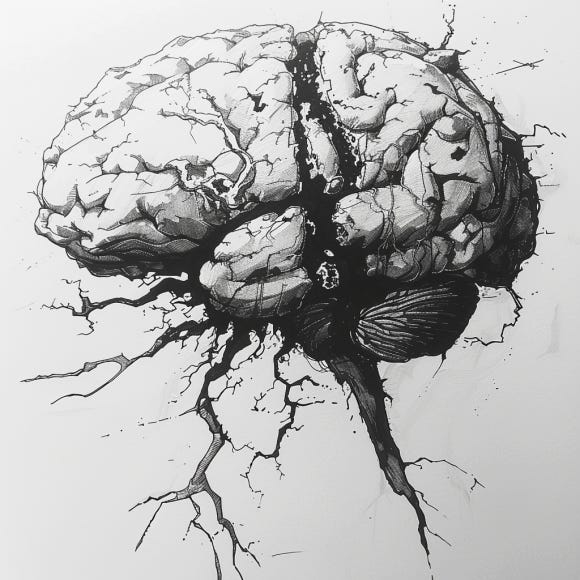The Art of Imperfection: Why Human Writing Continues to Resonate in an AI-Driven World
Teaching Students to Cultivate a Powerful Writing Practice in the Age of AI
Discover the Power of Human Writing in an AI-Driven World: 3 Key Insights
Embrace Imperfection: Learn why the gaps, hesitations, and asymmetries in human writing are not weaknesses, but rather powerful tools for exploring complex ideas and forging deep connections with readers.
Ground Your Writing in Human Experience: Understand how drawing upon your own emotions, relationships, and unique perspective can create writing that resonates with others on a profound level and inspires meaningful change.
Master the Art of Rhetorical Complexity: Gain insights into crafting persuasive, thought-provoking prose that employs advanced techniques to explore ideas with depth and nuance, setting your writing apart in an increasingly AI-generated landscape.
5 Ongoing Deficiencies of AI Writing
Excellent writing is a rare gift,and yet an acquirable skill. I have spent the past several weeks exploring the capabilities of Claude 3 Opus, arguably the most articulate of all large language models, and at times I have been frankly amazed by its output. In particular, I have found its ability to synthesize existing ideas and concepts very intriguing.
When asked to extend existing text, Claude has a slight edge over Gemini and ChatGPT. It doesn't break from the norm of offering up lengthy LLM lists of possible extensions. However, in every list of 10, at least 2 stand out as something I regard as genuinely useful. This compares to ChatGPT's and Gemini's usual 1 out of 10. Note that this is just my informal survey result.
All this said, Claude 3 Opus is still not a very good writer when left to its own resources and devices. When asked to create a generic story, letter, essay, etc., this model creates text that exhibits all the attributes described recently by Tony Berber Sardinha in his paper: "AI-generated vs human-authored texts: A multidimensional comparison.”
Tony Berber Sardinha: São Paulo Catholic University, Brazil
According to Sardinha's findings, AI-generated text demonstrates reduced involvement and integration, struggles with narrativity, deficiencies in referential language, imbalanced persuasive language, and inconsistent abstraction levels compared to human-authored texts. These limitations highlight the current state of AI writing capabilities and the areas where further advancements are needed to truly rival the craftsmanship of human writers.
Reduced Involvement and Integration:
AI conversations show less involvement and integration compared to human conversations.
AI-generated essays and news stories exhibit significant differences, with AI essays containing a higher density of information-carrying features.
Struggles with Narrativity:
AI has difficulty effectively incorporating narrative elements, especially in certain registers such as applied linguistics introductions, conversations, and news.
AI-generated texts in these registers lack the narrative integration found in their human-authored counterparts.
Deficiencies in Referential Language:
AI-generated academic texts, particularly in chemistry and applied linguistics introductions, fall short in incorporating explicit and context-dependent references compared to human-written texts.
AI struggles to generate referential language effectively in these academic contexts.
Imbalanced Persuasive Language:
AI tends to overcompensate in academic writing and news, producing texts that are nearly devoid of natural persuasive language, despite these registers typically lacking persuasive features.
In student essays and conversations, where persuasive elements are common in real-life contexts, AI-generated texts still fail to incorporate these features adequately.
Inconsistent Abstraction Levels:
AI-generated academic texts exhibit a deficiency in the abstraction indexing features found in human-authored texts.
In conversations, AI-generated dialogue tends to lean towards higher levels of abstraction, which is the opposite of human conversations that display a tendency towards non-abstraction.
The Writing / Thinking Correlation
In this article, I want to closely study a piece of excellent writing, one that comes with many assurances from its author that it was not composed with any recourse to AI tools. I aim to highlight what makes this mode of composition so special, not only aesthetically and linguistically but also rhetorically and cognitively.
My contention is that excellent writing is necessary as a tool for developing unique and new thought patterns and connections in the writer's mind. Moreover, it is also necessary for stimulating the kinds of partnerships between readers and writers that lead to innovative, lasting, and substantive changes in the world.
This argument does not preclude the power of hybrid composition. Indeed, hybridity will likely become the norm for most writing activities in the very near future. Rather, this argument seeks to situate a particular mode of written inquiry as a particularly powerful vehicle for thought constitution.
By doing so, we can ensure that we continue to protect and nurture this form of writing in our educational designs for the next school year and the years to come. As we navigate the rapidly evolving landscape of AI-assisted writing, it is crucial to recognize and preserve the cognitive and rhetorical benefits of traditional, human-driven writing processes.
Exemplary Writing Is Not Formulaic
When I first joined Substack, I instantly became a devoted follower of
. Not only does Alberto write on topics that are highly pertinent to my own work on AI and education, but he does so with incredible insight, nuance, and flair. His articles delve deep into the complexities of these subjects, offering a wealth of knowledge and fresh perspectives.Alberto's writing style is truly captivating, making even the most intricate concepts accessible and engaging to his readers. His work has undoubtedly enriched my understanding of these critical issues, and I am grateful to have discovered such a brilliant mind on this platform.
As we delve into a close analysis of a paragraph from Romero's thought-provoking essay, "My Kids Will Fancy Generative AI, I Choose to Fight It," we can see how his writing embodies the unique aesthetic, linguistic, rhetorical, and cognitive qualities that set human-authored text apart from AI-generated content:
I linger in the hope that the common factor among all the other inventions I just mentioned—the human user—cannot be replaced satisfactorily.
A: "This time it's different," I say to myself with a tone that sounds more confident than I am.
B: And it sure seems different; AI thinks for us.
C: That's not like past creative tools, isn't it?
D: We can't be "outthought".
E: That's our strength, our edge.
F: But we can't be sure. I'm not sure.
D: Or the hairs on the back of my neck wouldn't stand up at the thought of what's coming.
Romero's writing exemplifies the distinctive thought processes that characterize human cognition, filled with gaps, hesitations, revisitations, and revelations. His expansive "I" subject, which appears to be identical to his own person, is a highly purposive, argumentative entity that evolves within specific contexts.
This "I" undergoes states of development, rearrangement, transformation, and revelation, guided by Romero's keen intellect and rhetorical prowess. By contrast, AI-generated text often erases such spaces in pursuit of concision, order, and symmetry, lacking the depth and complexity of human thought.
The selected paragraph showcases Romero's exceptional skill in crafting persuasive and thought-provoking prose. He employs I-narration to create moments of tension, pause, release, reversal, and surprise insight within a highly condensed sequence of text.
This technique requires a particular habit of mind that actively questions the stakes of every proposition, considering them in light of a sometimes clear, sometimes yet-to-be-revealed higher value or criteria that drives the inquiry. The interplay between various "I" personas across Romero's body of work adds depth and complexity to his arguments, challenging readers to engage critically with the material and consider multiple perspectives simultaneously.
Rhetorically, Romero's text is a masterclass in the use of advanced techniques:
He introduces the topic of AI's threat to human livelihoods, qualifying it through the filter of his "hope" and the adverb "satisfactorily" (A).
He then engages in embedded speech, figuring himself as Lear on the heath, speaking to the reeds and rushes, not mustering any confidence in the words he speaks (B).
The next sentence marks a swift reversal, with AI taking the dominant subject position, rendering humanity the receiving object of the verb (C).
Romero drops an embedded rhetorical question, a quiet aside that begins declaratively and shifts into an interrogative (D).
The surface of his text boils over with advances and reversals, yet beneath the surface lies a deeper meaning. The next segment introduces another strong proclamation, reinforced by the royal "we" (E-F).
The paragraph's final thought, an incomplete sentence, communicates in form what Romero avoids saying explicitly in content (G-H): The future of jobs focused solely on the generation of words is highly uncertain.
This close analysis of Romero's writing illustrates the cognitive and rhetorical benefits of traditional, human-driven writing processes that we seek to preserve and nurture in our educational designs. The dynamic, adaptable "I" personas, the skillful use of rhetorical techniques, and the layered complexity of ideas demonstrate the unique qualities that set human-authored text apart from AI-generated content. Romero's text embodies a particular kind of thought process, one that is filled with gaps, hesitations, revisitations, and revelations. By contrast, AI-generated text often erases such spaces to pursue concision, order, and symmetry, lacking the depth and nuance of human cognition.
Exemplary Writing Is Referential
In conclusion, our in-depth exploration of Alberto Romero's writing serves as a celebration of the unique mode of thinking that characterizes human cognition and sets it apart from AI-generated content. Romero's work exemplifies the beauty and power of a thought process filled with gaps, hesitations, revisitations, reanalyses, asymmetries, and, ultimately, referentiality to the world. It is this distinctive human quality that imbues his writing with depth, nuance, and the ability to engage readers on a profound level.
Source: Dimitri Coelho Mollo, Raphaël Millière, “The Vector Grounding Problem”
As we navigate the rapidly evolving landscape of AI-assisted writing, it is crucial to recognize and cherish the inherent value of this human mode of thinking. Romero's prose is a testament to the fact that the imperfections, inconsistencies, and even the struggles that are part and parcel of human cognition are not weaknesses to be erased or smoothed over by AI, but rather strengths to be celebrated and nurtured. It is through these very gaps and asymmetries that we, as human writers, are able to explore complex ideas, challenge assumptions, and forge deep connections with our readers.
Moreover, Romero's writing is firmly grounded in the world, drawing upon a rich tapestry of experiences, emotions, and relationships that shape his unique perspective. This referentiality to the world is a hallmark of human writing, allowing us to create works that resonate with others on a profound level, sparking meaningful conversations and inspiring new ways of thinking. In contrast, AI-generated content, while often impressive in its coherence and fluency, lacks this essential connection to the world and the depth of understanding that comes with it.
As we look to the future of writing, it is clear that the preservation and celebration of this distinctly human mode of thinking must be a top priority. Rather than focusing solely on the potential pathways for integrating AI into the writing process, we must first and foremost recognize the immense value of the human cognitive experience, with all its gaps, hesitations, and beautiful asymmetries. By doing so, we can ensure that the art of writing remains a powerful tool for exploring the complexities of the human experience, fostering empathy and understanding, and effecting meaningful change in the world.
In the end, it is writers like Alberto Romero who remind us of the irreplaceable beauty and power of human cognition. By studying and emulating the aesthetic, linguistic, rhetorical, and cognitive qualities that make his writing so profound, we can cultivate a deeper appreciation for the unique strengths of the human mind and its ability to create works that touch the soul. As educators, writers, and researchers, our task is to champion this mode of thinking, to celebrate its imperfections and asymmetries, and to ensure that it continues to thrive in a world increasingly shaped by artificial intelligence.
Nick Potkalitsky, Ph.D.
Check out some of my favorite Substacks:
Educating AI is a reader-supported publication. To receive new posts and support my work, consider becoming a free or paid subscriber.
Subscribed




















Honored to be the subject of this amazing analysis, Nick! Superb explanations (you praise me too much 🙏🏻🙏🏻). I've tried and failed to put into words what you just described so well here. Important topic and great advice for young writers who want to know how to tap into their uniqueness as humans in the age of AI.
Thanks for the Sardinha synopsis and interesting insights into AI writing. As an ELF business communications teacher and applied linguistics researcher interested in L2 writing and genAI, I resonated with a number of your observations and you further clarified the research territory, too. I liked your analysis of Romero's writing, though that is more of a narrative genre not so applicable to most business and academic communications. I have recently analyzed default writings from GPT, Claude, and Gemini in more of a research writing context and specifically looking at readability from lexical and syntax complexity perspectives since so many L2 English speaking researchers are using ChatGPT to write up their research. but it was good that you helped me take off my blinders and consider other aspects of writing which I will focus on later. I have noticed and therefore have been recently interested in "AI-generated ... exhibit significant differences, with .... a higher density of information-carrying features" -- which makes it difficult to read. ChatGPT was the worst for this. :P
I enjoy your posts. Keep up the great work.